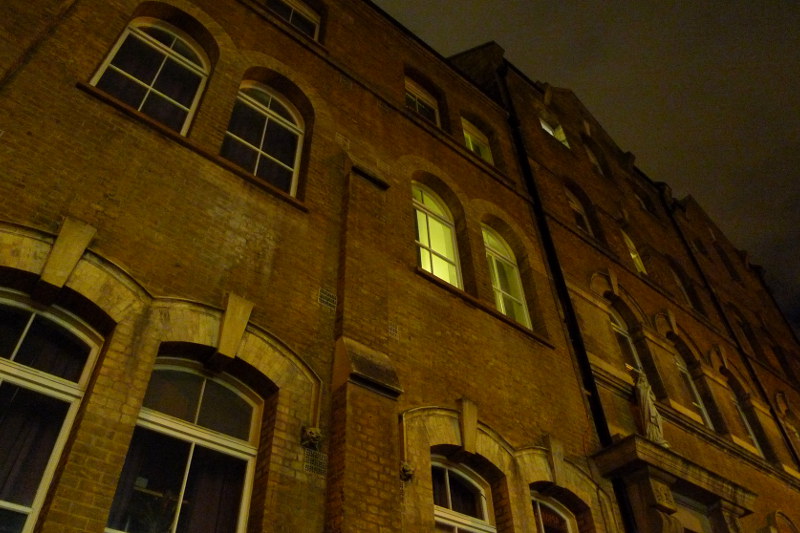One of the more popular London Tours is the Jack the Ripper Walk led by Donald Rumbelow, a British crime historian and Jack the Ripper expert. At the end of the tour you have the option of purchasing a copy of his book The Complete Jack the Ripper for £10. The brief details below come from the tour, supported by the book (because there is a dizzying amount of information about Jack the Ripper on the internet).
The tour starts at the Tower Hill Tube Station by the old walls of Londinium. It was here that I found the guide standing on his step stool so all in attendance could hear him describe the East End of London in 1888.
With images of Victorian London in our heads, we began our advance upon the mostly deserted streets of Whitechapel, so we could learn Jack’s horrendous story.
St. Botolph’s Church, Aldgate
The first stop on the tour is St. Botolph’s Church, Aldgate, otherwise known as the Church of Prostitutes. In Victorian England, if women were found loitering on street corners, they were quickly carted off to jail for prostitution. To avoid this, prostitutes would circle the Church of Prostitutes in an attempt to be incognito. It’s thought that on the night of her murder in 1888, Catherine Eddowes was doing just that.
Mitre Square
Mitre Square is a tiny little area with a small flower garden within walking distance of the Church of Prostitutes; not much in the square has changed since the 1800s. It was here that Catherine Eddowes’ body was found on September 30, 1888, brutally mutilated. She is the 4th canonical victim of Jack the Ripper.
The original cobblestones… where Catherine’s body was found.
On November 30, Catherine Eddowes was not the only woman murdered. Earlier in the night, a short distance away, Elizabeth Stride (3rd canonical victim) was found in Dutfield’s Yard. She was not mutilated and it’s thought that the murderer was interrupted before he could finish what he’d started. This is why he sought out Catherine Eddowes.
Petticoat Lane
Below we’re getting an explanation on Middlesex Street, close to Petticoat Lane, which is the boundary of the City of London and the East End. Catherine Eddowes was the only victim found within the boundaries of the City of London. All other victims were found in the East End. This caused a turf war between the London City Police and the Metropolitan Police Force.
Goulston Street
Below is the Brunswick House, which was built on the site of buildings (destroyed in WW2) where a blood-soaked portion of Catherine Eddowes’ apron was found on the night of her murder, under the following graffiti The Juwes are the men that will not be blamed for nothing. A few days later police received word a parcel in the mail that *allegedly* contained half of her kidney.
Providence Row Night Refuge Home and Convent of Mercy
The Night Home and Convent on Gun Street was a refuge for working girls. It’s rumoured that Mary Jane Kelly stayed here for a time. Mary Jane Kelly was the fifth and last of Jack’s canonical victims — and also the most brutally mutilated.
Spitalfields Market
A market has been on Commercial Street in Spitalfields since 1682. During the Ripper murders, the market looked very similar to the way it looks today (minus the neon and coloured glass panels). Every victim was found less than one mile from this spot.
The body of Annie Chapman, the Ripper’s second canonical victim, was found in the backyard of 29 Hanbury Street, just west of Brick Lane and a two-minute walk from Spitalfields Market.
The Ten Bells
Close to the Spitalfields market is The Ten Bells pub, on the corner of Commercial and Fournier Streets. Mary Jane Kelly (5th canonical) was seen soliciting business outside the pub a few hours before her death. She was murdered in her flat in Miller’s Court — one minute away from The Ten Bells.
This is where the tour ends… at the pub next to the church from which it gets its name: the Christ Church. The church was built in the 1700s with only one bell. At the same time that the pub was built, the church received its tenth bell. The pub’s name is in honour of this event.
